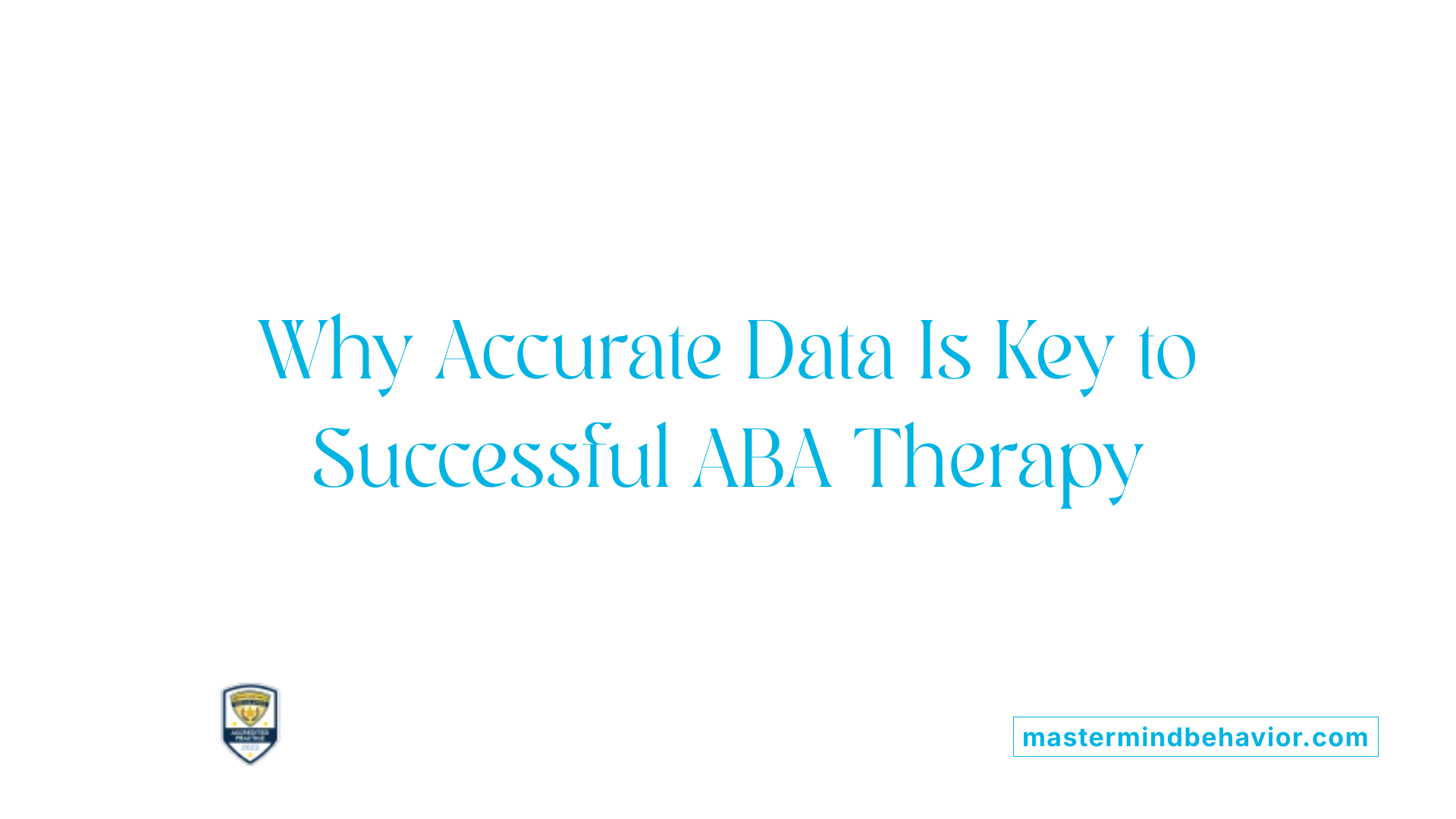The Role of Data Collection in ABA Therapy

Understanding the Critical Role of Data Collection in ABA Therapy
Applied Behavior Analysis (ABA) therapy is a cornerstone treatment for children with autism, heavily reliant on meticulous data collection. This process not only underpins the development of effective, personalized treatment plans but also ensures ongoing assessment, adjustment, and transparent communication among therapists, parents, and other caregivers. By systematically recording a child's behaviors and skills, clinicians can objectively measure progress, evaluate intervention effectiveness, and make evidence-based decisions that enhance therapeutic outcomes.
What is the Role of Data Collection in ABA Therapy?

How does data collection measure progress?
In ABA therapy, tracking a child's development is fundamental. Data collection involves recording behaviors, responses, and skill acquisitions systematically. By analyzing this information over time, therapists can determine whether the child is making progress toward their individualized goals. For example, frequency data can show how often a behavior occurs, while duration data might measure how long a skill is maintained.
Having clear, measurable data helps therapists gauge if interventions are effective or if adjustments are necessary. It provides an unbiased view of behavioral changes, ensuring progress isn't just perceived but supported by concrete evidence.
Why is assessing intervention effectiveness important?
Regular data collection directly influences the success of therapy strategies. It allows therapists to evaluate whether specific interventions are producing desired outcomes. If data shows limited progress or regress, adjustments can be made promptly.
Advanced techniques like interobserver reliability, where multiple observers compare data, help confirm accuracy and consistency. This assurance increases confidence in the results and assists in refining intervention methods, making treatment more targeted.
How do data collection practices aid in setting and adjusting goals?
Initial assessments offer a snapshot of a child's strengths and challenges, guiding goal setting. As therapy progresses, ongoing data collection reveals whether the goals are realistic or need modification.
When data shows steady progress, goals can be maintained or gradually intensified. Conversely, if data indicates stagnation or regression, goals may be lowered or adjusted to align with the child's current capabilities. This dynamic process ensures that goals remain relevant and achievable, supporting continued development.
In what ways does data collection help in tailoring treatment strategies?
Each child is unique, and data collection helps customize therapeutic approaches. By analyzing trends and patterns, therapists identify which strategies are effective and which are not.
For example, frequency and ABC data can reveal triggers for behaviors or responses to specific interventions. This insight allows clinicians to adjust techniques, modify reinforcement plans, and incorporate environmental changes suited to the child's needs.
Modern tools, including digital platforms and AI-powered systems like Raven Health, facilitate real-time data capture and analysis. These technologies support therapists in making swift, informed decisions to tailor treatments more precisely.
| Method of Data Collection | Purpose | Additional Details |
|---|---|---|
| Frequency & Rate | Track how often behavior occurs | Useful for behaviors that happen repeatedly |
| Duration | Measure how long behavior lasts | Ideal for assessing skill acquisition and behaviors with variable lengths |
| ABC Recording | Identify triggers and consequences | Helps understand causal factors behind behaviors |
| Interval & Time Sampling | Capture occurrence over specific periods | Suitable for behaviors that are difficult to record continuously |
| Parent & Teacher Reports | Collect natural environment data | Enhances understanding of behavior across settings |
Data collection remains a cornerstone of effective ABA therapy, supporting goal setting, progress tracking, and individualized treatment adjustments. Incorporating innovative tools and strategies ensures that intervention remains responsive and effective for each child.
Methods and Techniques for Data Collection in ABA

What methods are used for data collection in ABA therapy?
In Applied Behavior Analysis (ABA), several methods are employed to gather accurate and meaningful data about behaviors. Traditional techniques include frequency recording, which involves counting how often a specific behavior occurs within a given timeframe. Duration recording measures how long a behavior lasts, providing insights into its intensity and persistence.
ABC recording (Antecedent-Behavior-Consequence) is a comprehensive method that captures the environment before and after a behavior, helping identify triggers and effects. Scatterplot analysis visually maps behavior occurrences over time, highlighting patterns and routine times.
With technological advancements, automated data collection tools are becoming more common. These systems, typically computerized, can automatically record data during sessions, including behaviors that are difficult to observe directly, like private responses such as heart rate or physiological responses. These tools can handle large datasets more efficiently and reduce human error. However, their adoption in practice is still limited, with less than 10% of recent studies using such systems. Concerns about calibration, reliability, and standardization are reasons for cautious integration.
Typically, a mixed approach using manual observation complemented by digital tools offers the most comprehensive data collection strategy. By combining these methods, therapists ensure data accuracy, reliability, and depth.
How is probe data collected and what is its purpose?
Probe data is a specialized form of data collection used to evaluate skill acquisition. It involves assessing a child's abilities without providing prompts or assistance. This method helps determine whether a child can perform a skill independently, highlighting true mastery levels.
The purpose of probe data is to measure spontaneous use of skills and the maintenance of behaviors over time. It is often conducted periodically to monitor progress, especially in skills that are expected to generalize across different environments or contexts. Regular probing helps therapists decide when to introduce new targets or adjust existing interventions, ensuring that progress is sustained and skills are genuinely acquired.
Importance of Data Collection for Treatment Success

Why is data collection essential in ABA therapy?
In Applied Behavior Analysis (ABA), collecting data is the backbone of effective treatment. It provides the basis for making informed clinical decisions, ensuring that interventions are tailored and responsive to each child's progress. Reliable data helps therapists understand whether strategies are working or need adjustment. When data collection is inconsistent or inaccurate—often due to inadequate observer training or competing responsibilities—there's a risk of misjudging progress. Such issues can lead to misguided decisions, potentially hindering a child's development.
Regular, systematic data gathering allows clinicians to monitor real-time changes, evaluate the impact of interventions, and refine approaches. This level of attention to detail guarantees that therapy remains targeted and evidence-based. Ultimately, meticulous data collection results in better outcomes by guiding meaningful adjustments tailored to individual needs.
How does data collection influence treatment decisions and outcomes in ABA?
Data collection serves as a critical component in guiding treatment decisions within ABA therapy. By documenting behaviors through various methods like frequency, duration, latency, and ABC (Antecedent-Behavior-Consequence) recording, therapists can establish clear baselines. These baselines help set specific, measurable goals aligned with the child's development.
As therapy progresses, continuous data analysis reveals patterns and progress, enabling practitioners to make timely modifications that enhance effectiveness. For example, if data indicates that a behavior isn't decreasing as expected, the approach can be adjusted to better suit the child's unique responses.
Sharing progress data with parents promotes transparency and collaborative planning, reinforcing consistency across environments. This integrated approach ensures that interventions are precise and impactful. In sum, systematic data collection optimizes treatment efficacy by enabling deliberate, evidence-based decisions that support the child's growth and learning.
Data Collection and Its Impact on Designing Interventions

How does data collection influence treatment planning and intervention design?
Data collection is fundamental in guiding the development of effective behavior interventions. Through detailed recording of behavioral data, clinicians gain insights into the functions of behaviors and the skills that need reinforcement. For instance, behavioral assessments like functional behavior assessments (FBAs) explore the antecedents and consequences maintaining a behavior, helping therapists identify whether a behavior is driven by escape, attention, access to items, or sensory needs.
Task analysis, another crucial method, involves breaking down complex skills into smaller, teachable steps. Data collected during this process helps determine which steps may be challenging for the learner and need more targeted teaching.
The information derived from ongoing data analysis enables clinicians to match interventions to the individual child's needs. For example, if data shows a behavior occurs primarily in social contexts, therapy can focus on modifying social responses or teaching alternative communication strategies.
By examining patterns over time, therapists can adjust their approaches, measuring the effectiveness of interventions and making real-time modifications. This data-driven method ensures that interventions are not only tailored but also adaptable, leading to greater skill acquisition and behavior reduction.
Ultimately, systematic data collection informs every stage of treatment, from initial assessment to ongoing modifications, thereby maximizing the likelihood of meaningful progress for each child. It helps in designing precise, responsive strategies that are critical for successful ABA therapy.
The Role of Collaboration and Best Practices in Data Collection

Why is collaboration with parents and therapists important in data collection?
In ABA therapy, working closely with both parents and therapists is vital for gathering accurate and comprehensive data. When everyone shares observations and insights, it creates a clear and consistent picture of the child's behaviors across different environments and times. This teamwork helps tailor interventions specifically to each child's needs. Parents provide valuable information about behaviors in natural settings, which is essential for understanding progress beyond therapy sessions.
Regular communication and goal-setting between parents and therapists foster trust and mutual understanding. These updates ensure everyone stays aligned, making it easier to implement strategies consistently at home and in other settings. Ultimately, collaboration boosts the effectiveness of the treatment, accelerates progress, and helps achieve better developmental outcomes for the child.
What are best practices for data collection in ABA therapy?
Effective data collection relies on choosing reliable measurement methods suited to the targeted behaviors. Common techniques include frequency counts, duration checks, ABC recordings, and latency measures. It is critical to clearly define behaviors and establish standardized routines for recording data. Proper staff training ensures that everyone collects data consistently and accurately.
Using modern technology can greatly enhance this process. Digital platforms like Raven Health or Motivity allow real-time data entry, reduce errors, and facilitate instant analysis. Regular review of the data helps therapists identify trends, assess progress, and make informed decisions about adjusting interventions. Implementing these best practices ensures systematic, valid, and reliable data collection, supporting effective therapy planning and transparent progress reporting.
Additional Insights
| Aspect | Practice | Importance | Tools and Methods |
|---|---|---|---|
| Collaboration | Engage parents and therapists | Ensures comprehensive data and consistency | Regular meetings, communication channels |
| Standardization | Define behaviors and routines | Maintains data accuracy and reliability | Data sheets, checklists |
| Ethical practices | Respect privacy and obtain consent | Protects child rights, legal compliance | Secure data storage, informed consent |
| Technology integration | Use digital data collection platforms | Improves efficiency and accuracy | Raven Health, Motivity, real-time apps |
Using combined efforts and advanced tools, ABA practitioners can enhance the quality of data collection. This, in turn, leads to more precise, individualized interventions that support children's growth and learning.
Looking Ahead: The Future of Data in ABA Therapy
As technology advances, the future of data collection in ABA therapy promises to include sophisticated analysis tools, artificial intelligence integration, and enhanced collaboration platforms. These innovations aim to streamline data collection processes, improve accuracy, and facilitate real-time decision-making. Continued emphasis on training, ethical practices, and parental involvement will remain vital, ensuring that data collection continues to serve as the backbone of effective, personalized support for children with autism. Ultimately, robust data practices will lead to more precise, responsive, and successful interventions, helping children achieve meaningful growth and improved quality of life.
References
- Toward an Understanding of Data Collection Integrity - PMC
- The Importance of ABA Therapist Data Collection | All Star
- Types of ABA Data Collection Methods - Raven Health
- Data Collection in ABA Therapy for Children with Autism
- ABA Data Collection Methods: Types and Examples - Motivity
- Why Is Data Collection Important in ABA Therapy? | Blossom
- Why Is Collecting Data So Important in ABA Therapy? - BlueSprig
- The Importance of Data Collection in ABA Therapy
- How Data Collection in ABA Therapy Ensures Progress
- Understanding the Role of Data in ABA Therapy: How Progress is ...
Recent articles

How ABA Therapy Encourages Creative Play And Imagination
Unleashing Creativity: The Role of ABA Therapy in Enhancing Play and Imagination

How ABA Therapy Supports Healthy Daily Transitions At Home
Bridging Challenges: ABA Therapy's Role in Smooth Home Transitions for Children with Autism

How ABA Therapist Uses Data To Adjust Behavior Plans
Data-Driven Insights: Shaping Effective ABA Behavior Plans

ABA Therapy For Teaching Responsibility In Managing Schedules
Harnessing ABA Therapy to Cultivate Schedule Management Skills in Children with Autism

What Families Should Know About ABA Therapy Ethics And Consent
Understanding the Foundations and Ethical Framework of ABA Therapy

How ABA Providers Can Help Teachable Moments Arise Throughout the Day
Creating Learning Moments Anywhere: The Role of ABA Providers in Everyday Development



